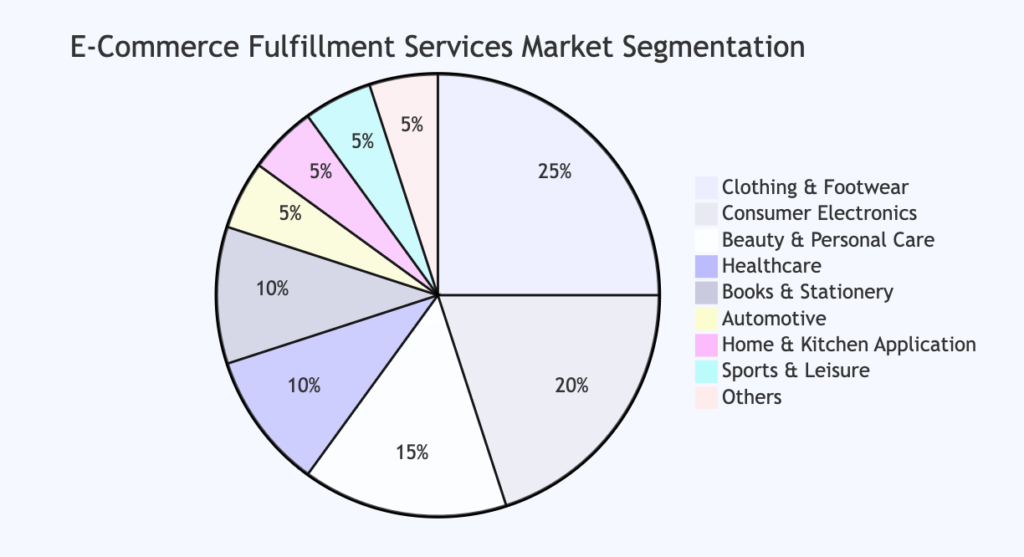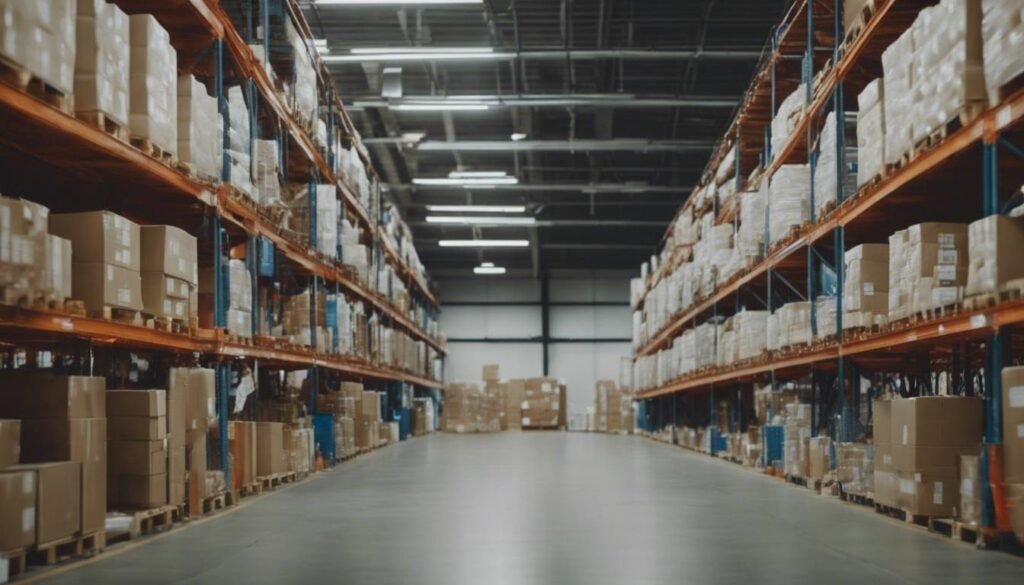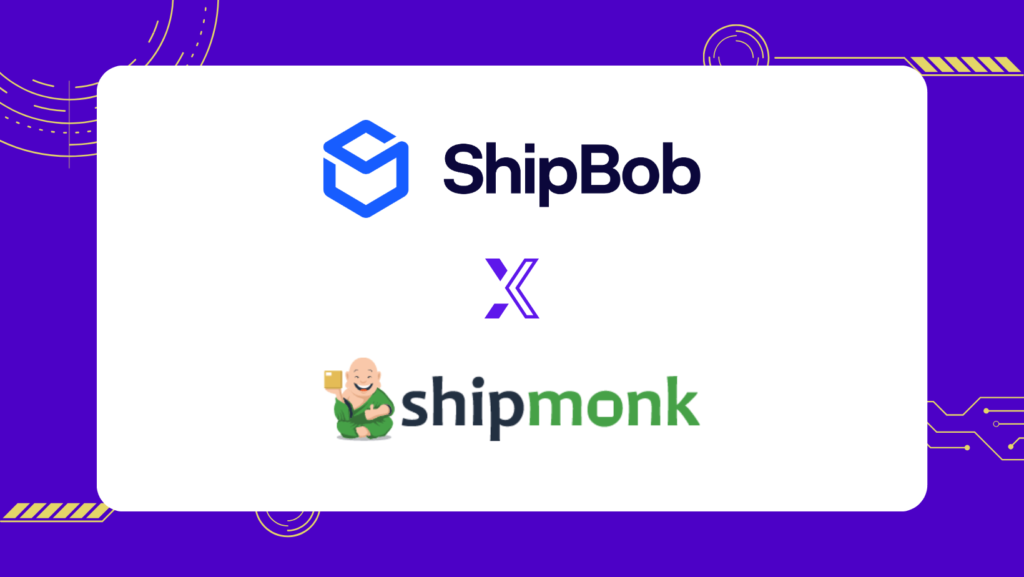Imagine clicking ‘buy’ on a website and soon having your order right at your doorstep. This seamless experience is the magic of retail fulfillment, a cornerstone in the e-commerce arena.
According to a report by Grand View Research, the global e-commerce fulfillment services market size was valued at USD 109.56 billion in 2023 and is projected to grow at a CAGR of 13.9% from 2023 to 2030.
E-Commerce Fulfillment Services Market Segmentation

When we look at retail fulfillment, it’s really interesting to see what parts of e-commerce are the biggest. Just like a pie is cut into slices of different sizes, the e-commerce fulfillment services market is made up of different parts, each with its own size. Some parts are bigger, some are smaller, but they all make up the whole picture.
Let’s check out these parts and see how big each one is in the world of retail fulfillment. This gives us a cool idea of what people are buying and selling the most online.

This growth symbolizes a fundamental shift in shopping habits and the rising importance of efficient fulfillment in meeting customer expectations.
With the expansion of online retail, businesses are rapidly integrating sophisticated, customer-centric retail fulfillment methods.
These are not just operational necessities but key strategies to enhance customer experiences, refine inventory management, and drive growth.
This guide covers everything such as the benefits of fulfillment, its intricate processes, effective strategies, and various models, all aimed at optimizing retail operations and elevating customer satisfaction in the vibrant world of retail.
The Five Key Steps in Retail Fulfillment
Let’s walk through the typical journey of an order in the retail fulfillment process:
- Receiving Inventory: It all starts when stores or warehouses receive goods from suppliers. Ensuring the accuracy of this inventory is crucial.
- Storing Inventory: Next, these items are stored efficiently in warehouses, ready to be picked for orders.
- Picking and Packing: When you place an order, someone in the warehouse picks the right item and packs it securely for shipping.
- Shipping: Your package is then dispatched through a delivery network to reach you as quickly as possible.
- Handling Returns: If something goes wrong, or you change your mind, there’s a process in place for returns and exchanges.
Each step is a cog in a larger machine, working together to ensure a seamless shopping experience.
In the next section, we’ll explore the different models of retail fulfillment and how they can impact both businesses and customers.
Exploring Different Retail Fulfillment Models

Choosing the right retail fulfillment model is crucial for any business’s success in the ever-evolving world of e-commerce and brick-and-mortar retail. Let’s dive deep into the most common models, examining their nuances, benefits, and challenges.
Third-Party Logistics (3PL)
Third-Party Logistics, commonly known as 3PL, is an outsourcing model where businesses hand over their logistics operations – including inventory management, warehousing, and shipping – to specialized companies. This model is gaining popularity among businesses that seek to focus on their core competencies while leveraging the expertise and infrastructure of logistics professionals.
Additionally, for those exploring dropshipping, working with dropshipping agents can be integrated into this model. These agents bridge the gap between your business and suppliers, streamlining the process even further and adding another layer of efficiency and scalability to your operations.

Advantages of 3PL: The primary advantage of 3PL providers lies in their logistics expertise. They bring a wealth of experience in managing complex supply chains, providing businesses with a range of services including transportation management, warehousing, cross-docking, inventory management, packaging, and freight forwarding.
For businesses looking to expand globally, 3PLs offer invaluable support in navigating international shipping regulations, customs processes, and global trade compliance. Moreover, 3PLs can provide scalable solutions that grow with your business, adapting to changing market demands and business volumes.
Challenges of 3PL: While 3PLs offer numerous benefits, there are challenges as well. One primary concern is the loss of control over logistics operations. Businesses relying on 3PLs might find themselves distanced from critical aspects of their supply chain. Additionally, while 3PLs offer cost efficiencies, these can be offset by the fees associated with their services. Selecting the right 3PL partner requires careful consideration of factors like compatibility, technological capability, and the ability to deliver personalized service.
Choosing a 3PL Provider: When selecting a 3PL provider, consider factors such as their technological capabilities, geographic coverage, expertise in your specific industry, and their track record of reliability and customer service. Assess their ability to integrate with your existing systems and processes. Look for providers who offer transparent communication and real-time data access for better control over your logistics operations.
Self-Fulfillment
Self-fulfillment, also known as in-house fulfillment, is where a business manages its entire logistics process internally. This model is often preferred by businesses that require tight control over their inventory and shipping processes, such as those with high-value products, complex customization needs, or a focus on brand experience.

Advantages of Self-Fulfillment: The biggest advantage of self-fulfillment is control. Businesses have direct oversight of their inventory, packaging, shipping, and customer service. This direct control can lead to a more cohesive brand experience and potentially faster response times to customer inquiries and issues. Additionally, self-fulfillment can be more cost-effective for businesses with a limited number of SKUs or lower shipping volumes.
Challenges of Self-Fulfillment: The main challenge of self-fulfillment lies in its resource intensity. It requires significant investment in warehouse space, technology, staffing, and logistics expertise. As a business grows, scaling self-fulfillment operations can become increasingly complex and costly. Additionally, managing logistics in-house requires staying current with the latest shipping regulations, technology trends, and logistics best practices.
Implementing Self-Fulfillment: Successful self-fulfillment requires meticulous planning and investment in infrastructure. Key considerations include optimizing warehouse layout for efficient order processing, investing in a reliable Warehouse Management System (WMS), training staff in efficient picking and packing techniques, and establishing robust inventory management practices. It’s also crucial to stay flexible and responsive to changes in order volume and customer preferences.
Dropshipping
Dropshipping is a fulfillment model where the retailer does not keep goods in stock but instead transfers customer orders and shipment details to either the manufacturer, another retailer, or a wholesaler, who then ships the goods directly to the customer. This model is particularly popular with e-commerce businesses due to its low overhead.

Advantages of Dropshipping: The primary advantage of dropshipping is its low barrier to entry. With no need for significant upfront investment in inventory or warehousing, it’s an accessible model for new entrepreneurs and businesses testing new markets or products. Dropshipping also offers the flexibility to offer a wide range of products without the risk of overstocking or unsold inventory.
Challenges of Dropshipping: The main challenge of dropshipping is the lack of control over inventory and shipping. This can lead to potential issues with stock availability, shipping delays, and product quality, all of which can impact customer satisfaction. Additionally, since dropshipping is a popular model, competition can be fierce, often leading to lower profit margins.
Maximizing Dropshipping: To succeed in dropshipping, it’s essential to choose reliable suppliers with quality products and efficient shipping practices. Building strong relationships with suppliers can help mitigate some of the risks associated with inventory and shipping. Focusing on niche markets or unique product offerings can also help differentiate your business in a crowded market.
👉 Read more about how you can make money with dropshipping in 2024.
In-Store Pickup (BOPIS)
Buy Online, Pick-up In-Store (BOPIS) is a hybrid model that combines online shopping with physical retail. Customers order products online and pick them up at a designated store location. This model has gained popularity due to its convenience and efficiency.

Advantages of BOPIS: BOPIS offers customers the convenience of online shopping with the immediacy of in-store pickup. It can lead to increased customer satisfaction and loyalty, and potentially higher in-store foot traffic and impulse purchases. For retailers, BOPIS can reduce shipping costs and turnaround times.
Challenges of BOPIS: The main challenge with BOPIS is the need for seamless integration of online and offline systems. Inventory management must be accurate to avoid customer disappointment with out-of-stock items. Additionally, stores need to have dedicated staff and space for BOPIS orders to ensure a smooth customer experience.
Implementing BOPIS: To implement BOPIS successfully, retailers must have an efficient system for online order management and real-time inventory updates. Training store staff to handle BOPIS orders effectively and designating specific areas for order pickup can enhance the customer experience. Promoting the BOPIS option through marketing and offering incentives can also drive adoption and increase sales.
Each of these fulfillment models offers unique advantages and poses different challenges. Your business’s choice will depend on factors like product type, market, scale, and control preferences. By carefully evaluating these aspects, you can select a model that aligns best with your operational goals and customer expectations.
Next, we’ll explore strategies to optimize your chosen retail fulfillment model, ensuring efficiency and customer satisfaction.
Strategies to Optimize Retail Fulfillment
Optimizing retail fulfillment is key to staying competitive in the fast-paced world of e-commerce. Implementing the right strategies can lead to smoother operations, happier customers, and a healthier bottom line. Let’s explore some effective tactics to elevate your retail fulfillment process.
Integrating Advanced Technology
Technology is a game-changer in retail fulfillment. From warehouse automation to real-time inventory tracking, tech solutions can drastically improve efficiency. Investing in a robust warehouse management system (WMS) is crucial to streamline operations and minimize errors.
Additionally, employing data analytics aids in demand forecasting and informed inventory decisions. For those considering e-commerce platforms, comparing options like Shopify and Magento can be vital. Each platform offers different integrations and capabilities that can significantly impact your fulfillment efficiency and overall e-commerce strategy.
Enhancing Shipping and Delivery
Shipping speed and reliability are crucial in customer satisfaction. Explore various shipping options and choose carriers based on cost-effectiveness and delivery speed. Offering multiple delivery choices, including expedited shipping or eco-friendly options, can also appeal to a broader range of customer preferences.
Improving Inventory Management
Effective inventory management ensures you have the right products at the right time, avoiding stockouts or overstocking. Regular inventory audits and leveraging predictive analytics for inventory forecasting are essential. Consider dropshipping for products with unpredictable demand to reduce inventory risks.
Focusing on Customer Service and Returns
A smooth return process and excellent customer service can turn a potentially negative experience into a positive one. Make sure your returns policy is clear and straightforward. Efficiently managing returns and exchanges can increase customer trust and loyalty.

By adopting these strategies, you can create a more responsive and efficient retail fulfillment system, ultimately leading to increased customer satisfaction and business growth. Remember, the goal is not just to deliver a product, but to deliver an experience that keeps customers coming back.
In the next section, we’ll go over 3 strategies that will take your retail fulfillment efficiency to the next level!
Three Key Strategies for Elevating Retail Fulfillment Efficiency
To keep your retail fulfillment process running like a well-oiled machine, it’s essential to constantly seek improvement. Here are three pivotal strategies to enhance efficiency and satisfaction in your fulfillment operations:
1. Revamping Your Warehouse Design
A well-thought-out warehouse layout is crucial for streamlining fulfillment. Consider these approaches:
- Streamlined Flow: Design your warehouse to minimize movement. Place popular items closer to packing stations and consider a logical flow from receiving to shipping.
- Flexible Storage Solutions: Adapt your storage solutions to different product types and sizes for easier access and better space utilization.
- Clear Signage and Organization: Implement clear signage and organized zones to reduce picking errors and save time.
2. Empowering Your Fulfillment Team
Your team is your biggest asset in fulfillment. Enhance their performance by:
- Comprehensive Training: Regular training sessions on inventory management, packing techniques, and safety protocols ensure higher efficiency and accuracy.
- Performance Incentives: Motivate your team with performance-based incentives to encourage faster and more accurate order processing.
- Adopting Ergonomic Practices: Design workspaces to reduce strain and fatigue, which can improve overall productivity and reduce errors.
3. Leveraging Technology and Automation
Incorporate technology to take your fulfillment process to the next level:
- Warehouse Management Systems (WMS): Implement a WMS for real-time inventory tracking, automated restocking alerts, and streamlined picking processes.
- Automation Tools: Consider using automated conveyors, robotic pickers, or packing machines to speed up the fulfillment process.
- Data Analytics: Use data analytics for predictive modeling of inventory needs, understanding customer buying patterns, and optimizing shipping routes.

By implementing these strategies, you can significantly enhance the efficiency of your retail fulfillment process, leading to happier customers and a more successful business. In the next section, we will conclude our guide with final thoughts and additional tips to help you effectively apply these strategies in your retail fulfillment journey.
Conclusion: Mastering Retail Fulfillment for Business Success
As we wrap up our comprehensive guide on retail fulfillment, it’s clear that mastering this aspect of business operations is crucial for success in today’s competitive market. Whether you choose Third-Party Logistics (3PL), embrace self-fulfillment, opt for the flexibility of dropshipping, or integrate the convenience of In-Store Pickup (BOPIS), the key is to align your fulfillment strategy with your business goals and customer expectations.

Retail fulfillment is not just about getting products from point A to point B. It’s about creating a seamless, efficient, and enjoyable experience for your customers. It’s about building trust, loyalty, and a reputation for reliability. By carefully selecting and optimizing your retail fulfillment model, you can turn this complex process into a significant competitive advantage.
In the dynamic landscape of retail, staying informed and adaptable is essential. Continuously evaluate your fulfillment strategies, keep an eye on emerging trends, and be ready to evolve as the market and your business grow.
Remember, effective retail fulfillment is a journey, not a destination, and it plays a pivotal role in the growth and sustainability of your business.
As you move forward, keep in mind that the world of retail fulfillment is ever-changing. Embrace innovation, prioritize customer satisfaction, and always strive for efficiency and excellence.
With the right approach and a clear understanding of your options, you can turn the challenge of retail fulfillment into a powerful driver of business success.







